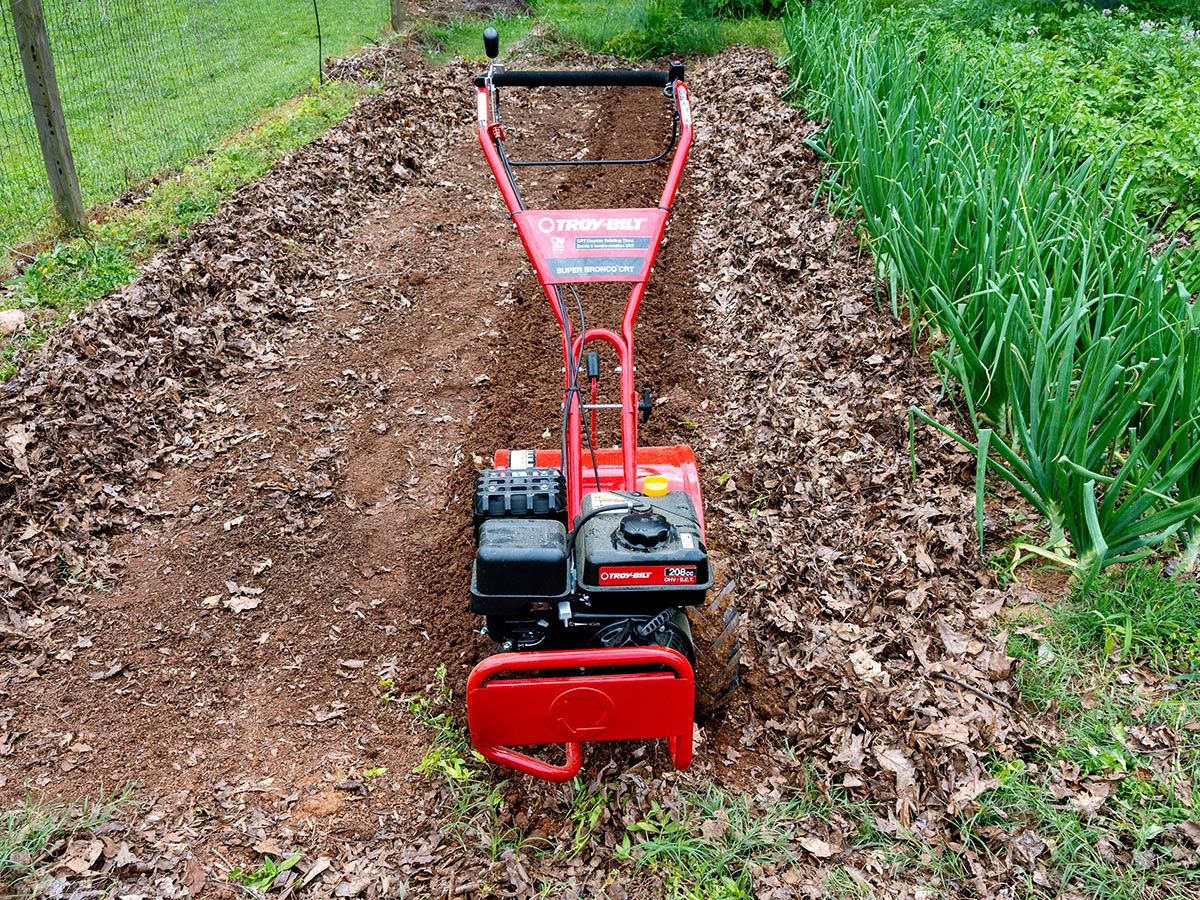

We may earn revenue from the products available on this page and participate in affiliate programs. Learn More ›
When it comes to breaking ground for a garden, there is not an easy solution. You could save money and spend more time and effort by using a shovel, or you can spend more money and save time and effort with a rototiller. These machines come in different shapes and sizes, from battery-powered mini cultivators to big rear-tine rototillers powered by gas engines. For intensive in-ground gardening on a larger scale, the rear-tine option is the most effective. I recently tested one of the most popular models, the Troy-Bilt Super Bronco CRT garden tiller.
Troy-Bilt invented the rototiller way back in 1937 and is still one of the best-known brands in the business. Whether you’re farming an acre of veggies, flowers, or herbs or a few hundred square feet, there’s a right-size Troy-Bilt tiller for the job. The Troy-Bilt Super Bronco CRT garden tiller is one of the company’s smaller rear-tine models, and it’s an ideal choice for backyard gardeners. Although it’s a great machine, it’s not suited for every garden. In the review ahead, I’ll offer my observations from testing the Troy-Bilt Super Bronco tiller for a month and turning 1,600 square feet of soil. (There are plenty of reasons it came out on top among several of the best rototillers I’ve used.)
Troy-Bilt Super Bronco CRT Garden Tiller: At a Glance
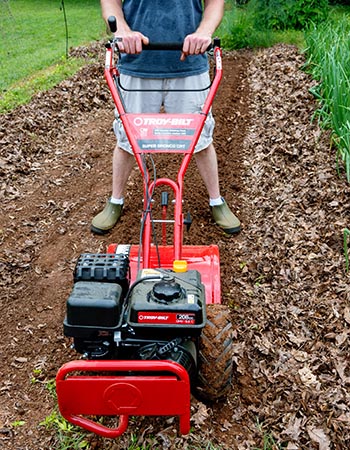
Rating: 4.8/5
SPECS
- Type: Rear tine
- Engine: 208cc gas engine
- Tilling width: 16 inches
- Tilling depth: 6 inches
- Weight: 184 pounds
WHAT WE LIKE
- 16-inch rear-tine rototiller is sized right for large garden beds
- Plenty of torque to till compacted garden soil and previously unbroken ground
- Balanced design and smooth tilling action for 1-handed operation
- 13-inch ag tires and power reverse improve maneuverability
- Bolo-style tines dig deep, blend soil effectively, and minimize clogging
WHAT WE DON’T LIKE
- Handles sometimes flex when steering in tightly compacted soil
- Wheels must be repinned for tilling versus transport while the engine is off
Get the Troy-Bilt Super Bronco CRT tiller at:
What is the Troy-Bilt Super Bronco CRT tiller?
The Troy-Bilt Super Bronco CRT tiller is one of the most popular rear-tine rototillers for turning compacted soil in large gardens. CRT stands for “counter-rotating tines,” which means that the tines rotate in the opposite direction of the wheels. This setup allows the machine to dig deeper with less effort than a forward-rotating tiller or cultivator.
The Super Bronco CRT tiller comes equipped with a 208cc gas engine, 13-inch air-filled agricultural tires, and 10-inch bolo-style tines. It also includes a power-reverse feature to help with end turns and maneuvering around obstacles. The tiller covers a 16-inch swath and reaches a maximum tilling depth of 6 inches.
I assembled the Super Bronco CRT this spring and tested it by turning my 1,500-square-foot vegetable garden and breaking ground on a new 100-square-foot flower bed. The clay-based soil and gently sloping terrain offered several important performance points to consider. When garden prep was over, I was pleased with the results. The tiller started easily each time and did a great job breaking ground and blending the soil. It was easy to operate along the long, straight runs. But I also noted a few design issues that, if addressed, could elevate the user experience.
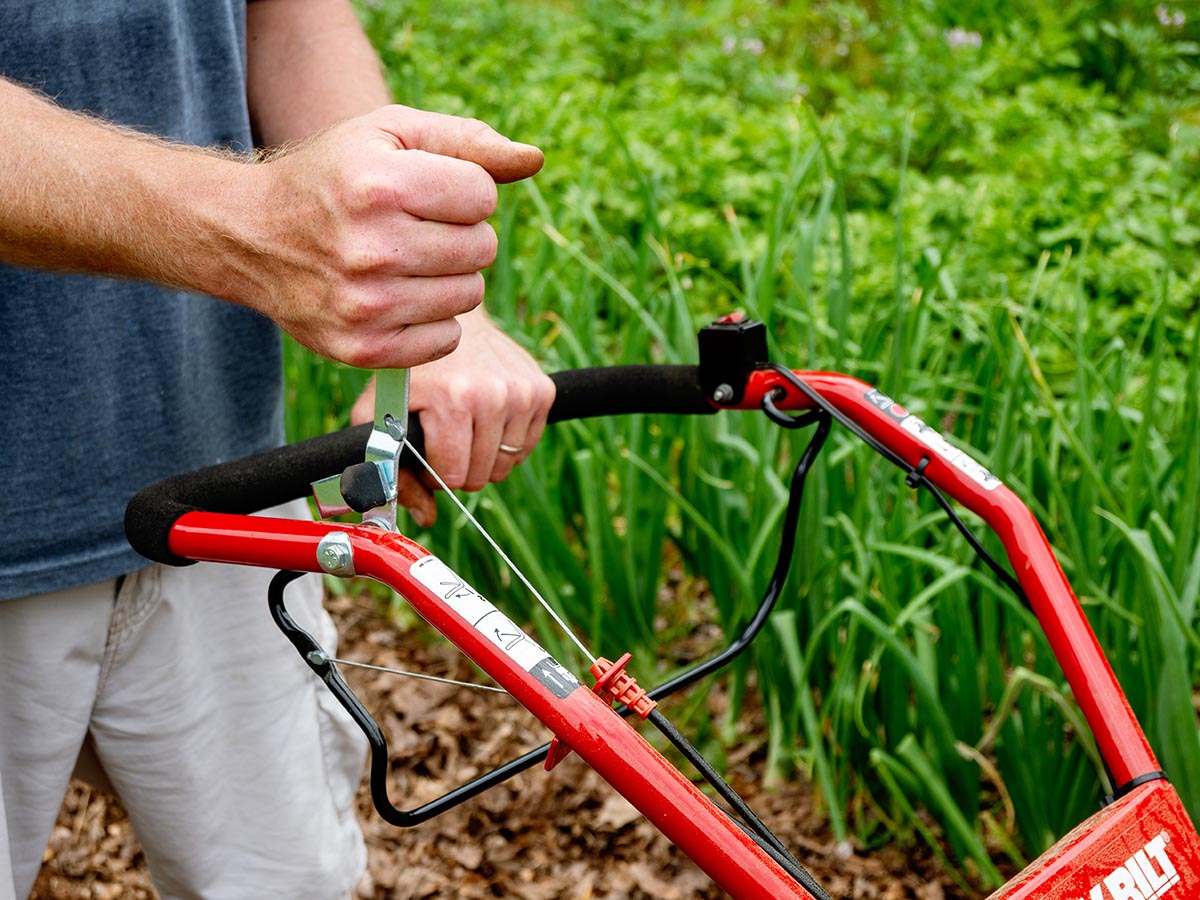
Starting
The Troy-Bilt Super Bronco CRT has a basic recoil starting system that works perfectly. It started easily, idled smoothly, and the engine ran quietly (for a gas-powered rototiller). When I applied the drive lever, the machine moved easily without jerky movements or excessive noise.
The engine typically started on the first pull after I’d set the choke. There was low resistance on the recoil cord, which made starting even easier. After I’d moved the choke lever to the run position, the engine idled very smoothly regardless of the throttle position. When I engaged the drive lever to start tilling, the engine continued to run smooth, strong, and steady under the load. The on/off switch located on the upper handle makes it fast and convenient to kill the engine in the event of an emergency.

Handling
The Super Bronco CRT has to be one of the easiest tillers to operate within its price range. The engine weight was well balanced ahead of the drive wheels in order to provide adequate downward pressure on the tines and drive wheels. The curved shape of the tines also added to the ease of handling, since they tended to kick out larger rocks rather than “jumping” over them.
Deep-treaded tires gave the machine good traction and stability in my gently sloped garden. I did not experience excessive lateral movement as I tilled along the contours. Turning at the row ends was easy enough thanks to the help of the powered-reverse feature, which I used to make three-point turns. It tracked very well in straight rows, making it easy to till up the larger vegetable plot. However, turning became cumbersome in the confines of the smaller flower bed.
Another nice feature was the padded loop handle. For my established garden, the loop handle design made it easy to control the machine with one hand while I was standing off to the side and out of the freshly tilled soil. This is much less doable with tillers that have bicycle-style handlebars.
I did not like that I had to reposition the wheels to switch between tilling mode and transport mode; there is no neutral gear. The axle only turns forward or backward while the engine is running and the engagement lever is activated. In tilling mode, the wheels are fixed to the axle, but in transport mode, the wheels spin freely around the axle.
Tilling Performance
I really liked this tiller’s smooth operation and aggressive tilling ability. The favorable weight balance, counterrotation, and curved-tine design allowed it to do its thing without transferring excessive jarring movements to the operator. It dug deep and remained stable while tilling. Any rocks I encountered, up to about the size of a softball, were simply deposited at the surface behind the tines.
One important note: Opening up a brand-new garden bed requires some change in operation. In tightly packed soil, the tires tended to slip as the tines tried to dig deeper. I countered that by raising the depth stake for shallow tilling on the first pass, then lowered the stake for a second, deeper pass. Double tilling was only necessary in unbroken ground.
- Works on previously unbroken soil
- Rotation speed breaks up clods and leaves behind a fine bed
- Tilled soil ends where it started; no windrows outside the tilling path
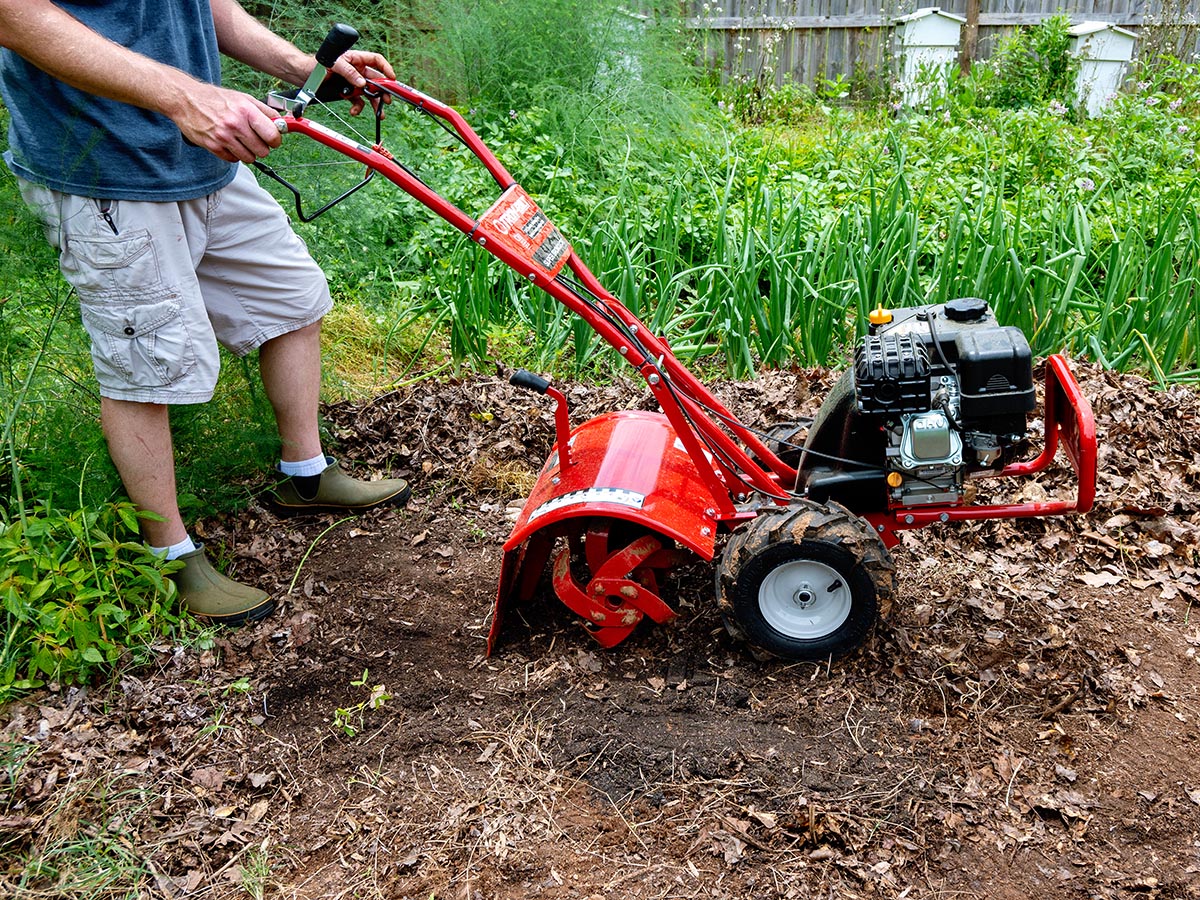
Durability
This Troy-Bilt rototiller packs plenty of tilling power with fewer breakable parts. If the smooth operation in my hard clay soil is an indication of durability, then the Super Bronco CRT checks the box. It easily withstood the challenges of compacted soil, large rocks, and buried tree roots without stalling out or even bogging down under the strain.
Compared to other rear tine tillers on the market, the Troy-Bilt Super Bronco CRT has fewer moving parts. The tines move in one direction, eliminating the need for a complicated transmission and shifter. The choke lever, throttle adjustment, and starter are all directly mounted on the engine, so there are no cables to maintain or linkages to go bad.
The tubular steel loop handle may be the weak point of this machine. It was sturdy enough for the straight runs, but it twisted and flexed somewhat when steering around obstacles, traveling along slope contours or turning at the ends of rows. After tilling 1,600 square feet, it showed no signs of wear or permanent damage. However, the twist/flex movement was noticeable during more strenuous maneuvers.
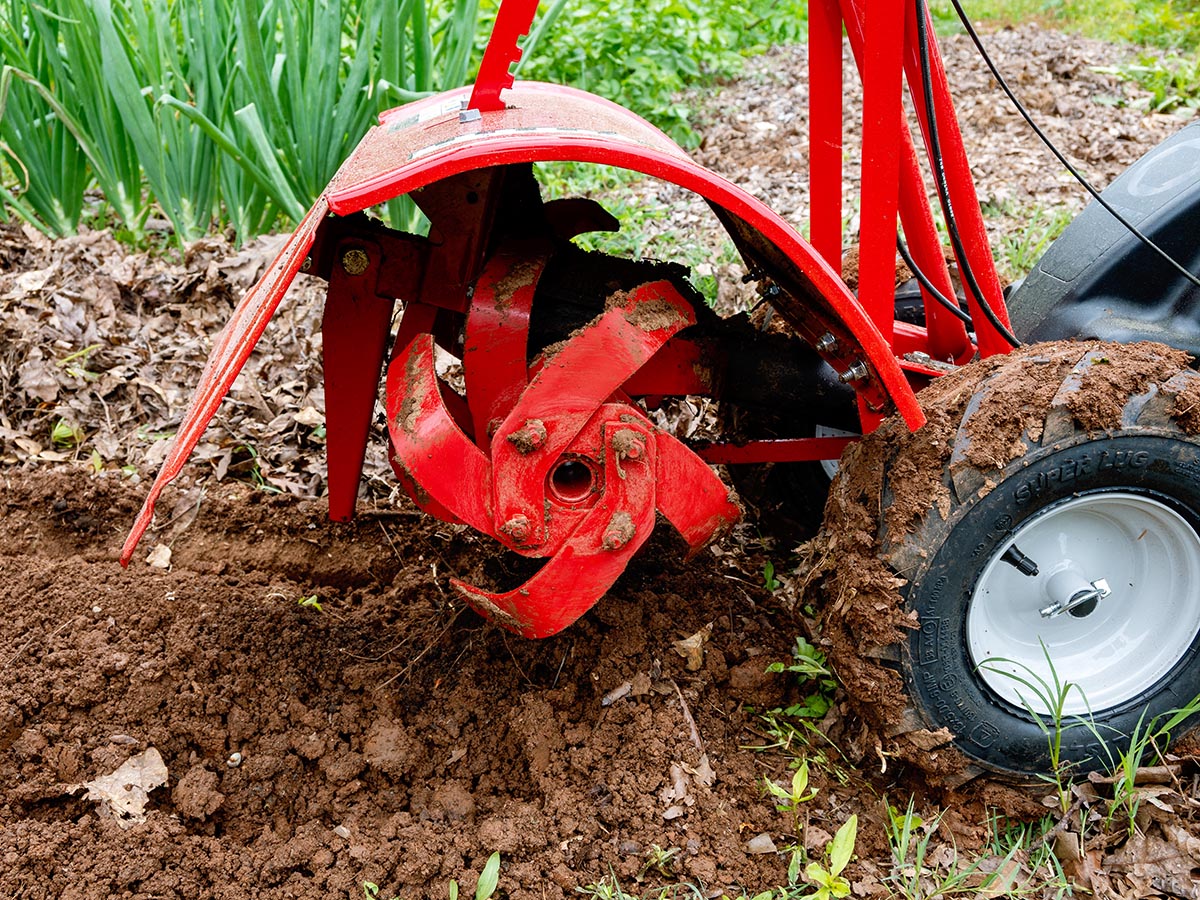
Is the Troy-Bilt Super Bronco CRT tiller worth the money?
Priced at just under $1,000, the Troy-Bilt Super Bronco CRT garden tiller is one of the more expensive rototillers of its kind. Other 16-inch rear-tine tillers range in price from about $700 to $1,400. Engine specifications and tilling dimensions are similar, so what’s the difference? Troy-Bilt’s simplified design and few extra features belie a machine that is designed and constructed better than cheaper alternatives.
As the original inventor of the rototiller, Troy-Bilt maintains a design advantage over other brands. The Super Bronco’s weight-forward design and smooth engine operation are both a cut above the cheaper competition. Also, Troy-Bilt’s tine assemblies are better, chopping heavy soils to a fine, loose texture and leaving behind a smooth bed instead of soil ridges. Less- expensive models may dig the soil, but they require more handwork after tilling.
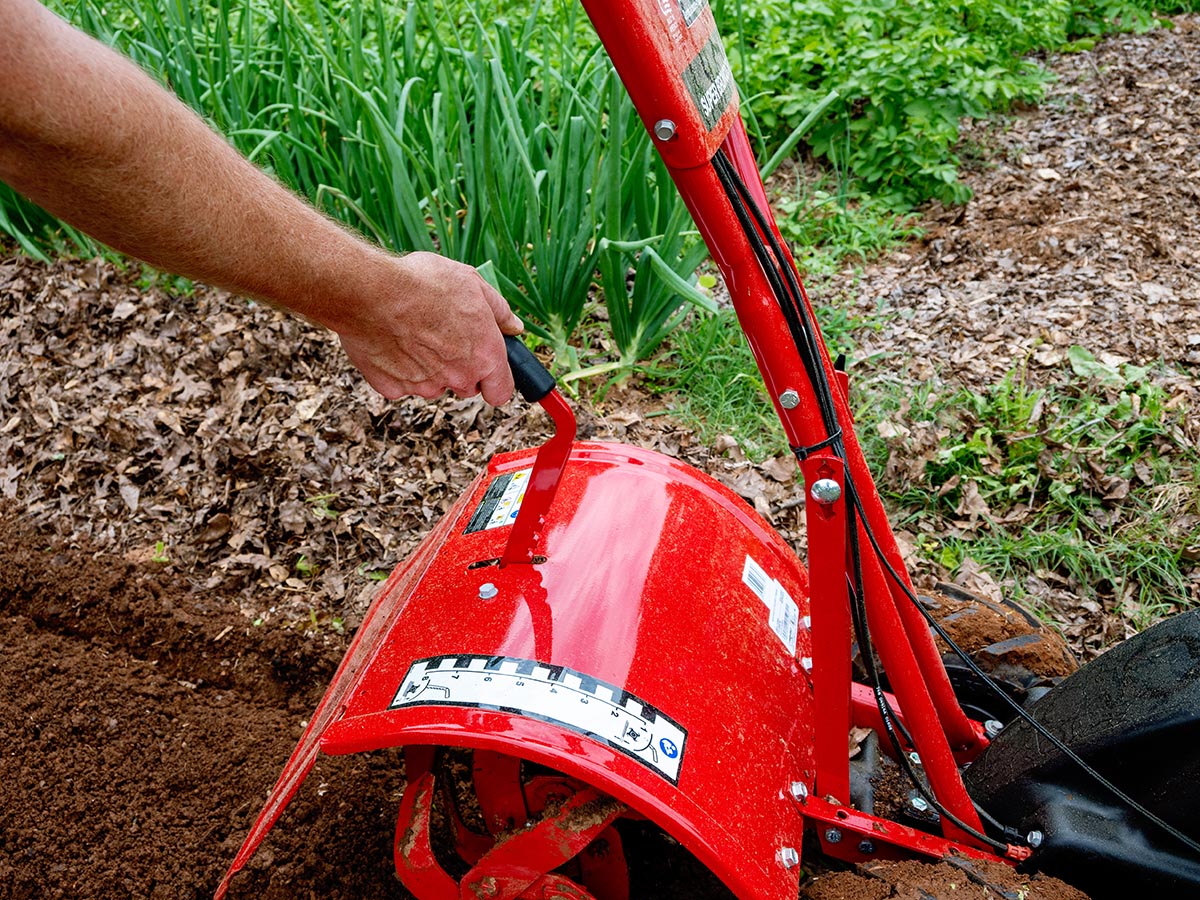
Should you buy the Troy-Bilt Super Bronco CRT tiller?
The Troy-Bilt Super Bronco CRT tiller is an ideal pick for big gardens, but it’s not the best choice for everyone. This tiller makes quick work of large garden plots, including heavy clay soils and sod busting for new garden plots. It works long, straight lines with ease. It is a smart choice for spring garden preparation, fall garden cleanup, and cultivating garden pathways during the season. But it is too big for precision cultivation among young plants. Its weakness is turning, so it becomes too cumbersome to manage in smaller gardens.
If you need a sturdy, easy-to-use tiller for a midsize or larger garden plot that can be tilled in long, straight rows, then the Troy-Bilt Super Bronco CRT tiller could be a great option. It packs plenty of digging power, smooth operation, and a simple design that is built to last.
Get the Troy-Bilt Super Bronco CRT tiller at:
Meet the Tester
As a 20-year veteran landscaper, Mark Wolfe now writes and tests products with a focus on mechanical durability and user convenience. His large yard provides plenty of opportunities to test powerful gardening equipment.
